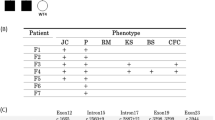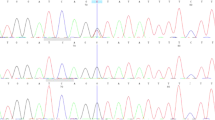Abstract
Nevoid basal cell carcinoma syndrome (NBCCS) is an autosomal dominant disorder characterized by developmental defects and tumorigenesis such as medulloblastomas and basal cell carcinomas, caused by mutations of the patched-1 (PTCH1) gene. To date, we have detected 73 mutations in PTCH1 and ten of them (14 %) were suspected splicing mutations. Eight out of the ten mutations were localized near the splice donor site. Five mutations were localized within the invariant GT-AG splice site, whereas the other five mutations occurred outside the invariant GT-AG site including the last exonic nucleotide. When the transcripts were examined, all mutations resulted in aberrant splicing, including exon skipping or the activation of cryptic splice sites. This is the first extensive report of NBCCS focusing on splice site mutations, and it highlights the importance of analyzing transcripts especially for mutations lying outside the GT-AG splicing consensus site. In addition, the splice site score calculated by Splice-Site Analyzer Tool provided by Tel Aviv University helped predict aberrant splice patterns in most of the cases.



Similar content being viewed by others
References
Gorlin RJ (1987) Nevoid basal-cell carcinoma syndrome. Med (Baltim) 66:98–113
Evans DG, Howard E, Giblin C, Clancy T, Spencer H, Huson SM (2010) Birth incidence and prevalence of tumor-prone syndromes: estimates from a UK family genetic register service. Am J Med Genet A 152A:327–332
Shanley S, Ratcliffe J, Hockey A, Haan E, Oley C, Ravine D, Martin N, Wicking C, Chenevix-Trench G (1994) Nevoid basal cell carcinoma syndrome: review of 118 affected individuals. Am J Med Genet 50:282–290
Endo M, Fujii K, Sugita K, Saito K, Kohno Y, Miyashita T (2012) Nationwide survey of nevoid basal cell carcinoma syndrome in Japan revealing the low frequency of basal cell carcinoma. Am J Med Genet A 158A:351–357
Fujii K, Ohashi H, Suzuki M, Hatsuse H, Shiohama T, Uchikawa H, Miyashita T (2013) Frameshift mutation in the PTCH2 gene can cause nevoid basal cell carcinoma syndrome. Fam Cancer 12:611–614
Kijima C, Miyashita T, Suzuki M, Oka H, Fujii K (2012) Two cases of nevoid basal cell carcinoma syndrome associated with meningioma caused by a PTCH1 or SUFU germline mutation. Fam Cancer 11:565–570
Smith MJ, Beetz C, Williams SG, Bhaskar SS, O’Sullivan J, Anderson B, Daly SB, Urquhart JE, Bholah Z, Oudit D, Cheesman E, Kelsey A, McCabe MG, Newman WG, Evans DG (2014) Germline mutations in SUFU cause Gorlin syndrome-associated childhood medulloblastoma and redefine the risk associated with PTCH1 mutations. J Clin Oncol 32:4155–4161
Johnson RL, Rothman AL, Xie J, Goodrich LV, Bare JW, Bonifas JM, Quinn AG, Myers RM, Cox DR, Epstein EH Jr, Scott MP (1996) Human homolog of patched, a candidate gene for the basal cell nevus syndrome. Science 272:1668–1671
Hahn H, Wicking C, Zaphiropoulous PG, Gailani MR, Shanley S, Chidambaram A, Vorechovsky I, Holmberg E, Unden AB, Gillies S, Negus K, Smyth I, Pressman C, Leffell DJ, Gerrard B, Goldstein AM, Dean M, Toftgard R, Chenevix-Trench G, Wainwright B, Bale AE (1996) Mutations of the human homolog of Drosophila patched in the nevoid basal cell carcinoma syndrome. Cell 85:841–851
Ingham PW, McMahon AP (2001) Hedgehog signaling in animal development: paradigms and principles. Genes Dev 15:3059–3087
Krawczak M, Reiss J, Cooper DN (1992) The mutational spectrum of single base-pair substitutions in mRNA splice junctions of human genes: causes and consequences. Hum Genet 90:41–54
Bholah Z, Smith MJ, Byers HJ, Miles EK, Evans DG, Newman WG (2014) Intronic splicing mutations in PTCH1 cause Gorlin syndrome. Fam Cancer 13:477–480
Kimonis VE, Goldstein AM, Pastakia B, Yang ML, Kase R, DiGiovanna JJ, Bale AE, Bale SJ (1997) Clinical manifestations in 105 persons with nevoid basal cell carcinoma syndrome. Am J Med Genet 69:299–308
Suzuki M, Nagao K, Hatsuse H, Sasaki R, Saito K, Fujii K, Miyashita T (2013) Molecular pathogenesis of keratocystic odontogenic tumors developing in nevoid basal cell carcinoma syndrome. Oral Surg Oral Med Oral Pathol Oral Radiol 116:348–353
Maquat LE (2002) Nonsense-mediated mRNA decay. Curr Biol 12:R196–R197
Shapiro MB, Senapathy P (1987) RNA splice junctions of different classes of eukaryotes: sequence statistics and functional implications in gene expression. Nucleic Acids Res 15:7155–7174
Carmel I, Tal S, Vig I, Ast G (2004) Comparative analysis detects dependencies among the 5′ splice-site positions. RNA 10:828–840
Wicking C, Shanley S, Smyth I, Gillies S, Negus K, Graham S, Suthers G, Haites N, Edwards M, Wainwright B, Chenevix-Trench G (1997) Most germ-line mutations in the nevoid basal cell carcinoma syndrome lead to a premature termination of the PATCHED protein, and no genotype-phenotype correlations are evident. Am J Hum Genet 60:21–26
Burset M, Seledtsov IA, Solovyev VV (2001) SpliceDB: database of canonical and non-canonical mammalian splice sites. Nucleic Acids Res 29:255–259
Teraoka SN, Telatar M, Becker-Catania S, Liang T, Onengut S, Tolun A, Chessa L, Sanal O, Bernatowska E, Gatti RA, Concannon P (1999) Splicing defects in the ataxia-telangiectasia gene, ATM: underlying mutations and consequences. Am J Hum Genet 64:1617–1631
Nozu K, Vorechovsky I, Kaito H, Fu XJ, Nakanishi K, Hashimura Y, Hashimoto F, Kamei K, Ito S, Kaku Y, Imasawa T, Ushijima K, Shimizu J, Makita Y, Konomoto T, Yoshikawa N, Iijima K (2014) X-linked Alport syndrome caused by splicing mutations in COL4A5. Clin J Am Soc Nephrol 9:1958–1964
Dong J, Gailani MR, Pomeroy SL, Reardon D, Bale AE (2000) Identification of PATCHED mutations in medulloblastomas by direct sequencing. Hum Mutat 16:89–90
Pastorino L, Cusano R, Nasti S, Faravelli F, Forzano F, Baldo C, Barile M, Gliori S, Muggianu M, Ghigliotti G, Lacaita MG, Lo Muzio L, Bianchi-Scarra G (2005) Molecular characterization of Italian nevoid basal cell carcinoma syndrome patients. Hum Mutat 25:322–323
Smyth I, Wicking C, Wainwright B, Chenevix-Trench G (1998) The effects of splice site mutations in patients with naevoid basal cell carcinoma syndrome. Hum Genet 102:598–601
Evans DG, Bowers N, Burkitt-Wright E, Miles E, Garg S, Scott-Kitching V, Penman-Splitt M, Dobbie A, Howard E, Ealing J, Vassalo G, Wallace AJ, Newman W, Northern UK, Huson SM, NF1 Research Network (2016) Comprehensive RNA analysis of the NF1 gene in classically affected NF1 affected individuals meeting NIH criteria has high sensitivity and mutation negative testing is reassuring in isolated cases with pigmentary features only. EBioMedicine 7:212–220
Wappenschmidt B, Becker AA, Hauke J, Weber U, Engert S, Köhler J, Kast K, Arnold N, Rhiem K, Hahnen E, Meindl A, Schmutzler RK (2012) Analysis of 30 putative BRCA1 splicing mutations in hereditary breast and ovarian cancer families identifies exonic splice site mutations that escape in silico prediction. PLoS ONE 7:e50800
Cartegni L, Chew SL, Krainer AR (2002) Listening to silence and understanding nonsense: exonic mutations that affect splicing. Nat Rev Genet 3:285–298
Uchikawa H, Fujii K, Kohno Y, Katsumata N, Nagao K, Yamada M, Miyashita T (2007) U7 snRNA-mediated correction of aberrant splicing caused by activation of cryptic splice sites. J Hum Genet 52:891–897
Du L, Pollard JM, Gatti RA (2007) Correction of prototypic ATM splicing mutations and aberrant ATM function with antisense morpholino oligonucleotides. Proc Natl Acad Sci USA 104:6007–6012
Taniguchi-Ikeda M, Kobayashi K, Kanagawa M, Yu CC, Mori K, Oda T, Kuga A, Kurahashi H, Akman HO, DiMauro S, Kaji R, Yokota T, Takeda S, Toda T (2011) Pathogenic exon-trapping by SVA retrotransposon and rescue in Fukuyama muscular dystrophy. Nature 478:127–131
Acknowledgments
The authors acknowledge the cooperation of the attending physicians in this study. This study was supported by Ministry of Education, Culture, Sports, Science and Technology of Japan Grant-in-Aid for Scientific Research (KAKENHI) 26461530 (to T. M.), 15K19041 (to K. N.) and 16K09960 (Katsunori Fujii) and by a grant from Kitasato University Graduate School of Medical Sciences (Integrative Research Program 2015–2016) (to T. M.).
Author information
Authors and Affiliations
Corresponding author
Rights and permissions
About this article
Cite this article
Kato, C., Fujii, K., Arai, Y. et al. Nevoid basal cell carcinoma syndrome caused by splicing mutations in the PTCH1 gene. Familial Cancer 16, 131–138 (2017). https://doi.org/10.1007/s10689-016-9924-2
Published:
Issue Date:
DOI: https://doi.org/10.1007/s10689-016-9924-2




